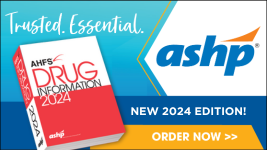This information has been compiled using publicly available information on established best practices. ASHP and the University of Utah have provided this fact sheet for informational purposes only and are not assuming any liability for the accuracy or completeness of the information provided.
Introduction
This fact sheet summarizes the status of the current acute shortage of small- and large-volume intravenous solutions and provides potential actions for organizations to consider in managing the shortages. Healthcare practitioners should use their professional judgment in deciding how to use the information in this document, taking into account the needs and resources of their individual organizations.
Why is Conservation Necessary?
Intravenous solution producers Baxter, BBraun, Fresenius Kabi, Grifols Laboratories, and ICU Medical have a large variety of intravenous solution presentations on allocation.1,2 This is due in part to COVID-related workforce and production challenges. Additionally, shortages of small vials of sterile water and sodium chloride, as well as dextrose 25% and 50% prefilled syringes have created additional demand for small volume fluids. As demand increases for small volume fluids, this creates additional demand for large volume fluids. No supplier has excess capacity to increase production to allow for sufficient supplies.
Shortages of intravenous solutions continue to plague hospitals, healthcare systems, ambulatory care infusion centers, and home infusion agencies. At times the supply of these products is so heavily impacted that alternative strategies are needed. Intravenous solutions are the foundation of basic medication preparation and compounding for hundreds of drugs that need reconstitution and/or further dilution. Hospitals that do not serve a large population of pediatric patients often don’t routinely utilize syringe pump infusion technology, instead using large volume infusion pumps that require the final compounded solution to be in bags or bottles. Glass bottles are not only cumbersome, they are hazardous to staff and patients if they break, and their use is only recommended if the drug requires a glass container based upon stability needs.
Definitions
Small-volume parenteral solutions (SVPs) — a solution volume of 100 mL (as defined by USP) or less that is intended for intermittent intravenous administration (usually defined as an infusion time not lasting longer than 6-8 hours).
IV push — Despite the often ambiguous nature of this term, it generally is considered administration of a final IV product that can be injected over 5 minutes or less. Best practice recommends that whenever possible the actual rate of IV push administration specific to a given drug be noted and that terms such as IV push (unspecified), IV bolus (unspecified), slow or fast/rapid IV push should be avoided.
Ready-to-administer — A dosage form/concentration that can be administered to the patient without further manipulation.
What Can Clinicians Do to Conserve?
- Review the use of SVPs as supplies. Many areas use SVPs to start intravenous lines, administer blood, or flush lines. During these shortages, consider using single-use flush syringes when possible, although shortages exist for these products as well.
- Switch products to IV push whenever possible.
- Adhere to the CDC use guidelines for single-use vials.3
- System-wide communication will be needed to alert all clinicians who administer medications.
- Change medications and electrolytes to a clinically appropriate oral product whenever possible.
- Work with the organization’s P&T committee, or equivalent, to review current IV to oral (PO) policies.
- Policies may need to be expanded to include other drug classes.
- Switch antimicrobials to oral dosage forms when clinically appropriate, especially for antibiotics that have good bioavailability.
- If oral route is not feasible or indicated, some medications can be administered via intramuscular and/or subcutaneous injection.
- Adhere to recommended maximum volumes for a single injection; doses may need to be divided into more than one syringe.
- Consider alternative intravenous solutions when therapeutic interchange is not clinically important (e.g. maintaining line patency, for blood administration, etc.).
- Review the stock of small volume bags and vials to determine stock on hand that is compatible with mix-on-demand supplies such as Vial2Bag®, Add-Vantage®, or Mini-Bag™ Plus.
- Do not make practice change plans that will require additional fluids or specific products (e.g. requiring additional mix-on-demand supplies).
Inventory Control Strategies
- Evaluate supplies on a health-system-wide basis and redeploy fluids to areas of greatest need.
- Stock SVPs only in areas where medications must be prepared to conserve use and consolidate supplies to necessary locations.
- Ensure that purchasing agents have active backorders in place, and are obtaining allocations as available. Work with local sales representatives if a lack of appropriate allocations is creating patient care challenges.
Pharmacy Operational Strategies
- Transition to commercially manufactured premix medications when available.
- Leverage admixtures available from 503B outsourcers when available.
- Consider changes in the electronic health record (EHR) to allow the use of either dextrose or saline for admixture of drugs compatible with both solutions. This will help create better flexibility based upon which products are available at the time.
- Use EHR alerts or forced functions when a drug is compatible in only one diluent.
- Implement or encourage the use of barcode scanning of ingredients to ensure the correct solution is used and documented.
- Consider preparing and dispensing medications that may be administered IV push in ready-to-administer concentrations packaged in syringes.
- Home infusion references can provide information on maximum concentrations to minimize volumes to be administered.
- If your institution can utilize syringe infusions pumps, consider preparing and dispensing non-IV push medications in ready-to-administer syringes to be infused via syringe pump.
- If empty bags are available, and all other options have been exhausted, consider compounding SVPs of 5% Dextrose or 0.9% Sodium Chloride.
- The preferred method for these preparations is to use 1 L bags of commercially available 5% Dextrose or 0.9% Sodium Chloride to repackage into smaller bag sizes (50, 100, or 250 mL).
- Alternatively, these may be compounded using concentrated dextrose or sodium chloride respectively (considered medium-risk by USP <797> standards) and further diluting with sterile water.
- Repeater pumps can be used for compounding and will help ensure accuracy and minimize employee fatigue and over-use injuries.
- If compounded or repackaged bags have been frozen to extend dating, thoroughly inspect the bag before dispensing to ensure the bag did not crack or split during frozen storage.
- Follow USP Chapter <797> and state rules and regulations for determining applicable beyond-use dates.
- Only compound in an empty container that adequately reflects the final volume: for example, 100 mL of solution in a 100mL empty container.
- If necessary to compound in a bag with larger capacity than the final volume of solution, the pharmacy label should be affixed so that it covers the empty capacity printed on the bag. For example, if compounding 50 mL total volume in a 150 mL container the pharmacy label should cover the 150 mL print on the bag.
- Ensure that refrigerators and freezers are continuously monitored.
- Double check that they are plugged into emergency power outlets.
- Do not overfill the refrigerator or freezer; that would be detrimental to maintaining optimal temperatures.
Infusion Pumps / Informatics Strategies
- Allocate appropriate clinical informatics resources to manage difficult times during critical shortages.
- Drug records, order-sets, and treatment protocols will need to be reviewed for route changes of some IV medications.
- These may include solutions used for medication dilution or solutions available for line patency.
- Take the opportunity to review, revise, and/or develop good infusion pump practices and protocols.
- These are needed to ensure that the institution knows how many pumps are available at all times and where they need to be allocated.
- Consider where and when other types of pumps can be used such as PCA, CADD, or elastomeric pumps.
- Try to maintain standardization whenever possible, especially if the same pumps are used for both adult and pediatric patients.
Caveats / Safety information
- ISMP has specific recommendations to ensure patient safety related to the shortage of sodium chloride and sterile water small vials.4
- Adequately communicate any changes to current practice using established communication channels within your hospital or health system, such as EHR alerts, emails, daily huddles, flyers, labeling, etc.
- Be sure that the clinical informatics team is aware of the need to make priority changes in drug records, charge description masters, and infusion pump libraries and recognize that they will not have the normal lead time that this process generally requires.
- Consider having a physician and nursing champion in addition to the pharmacy lead who can assist with routine communication, practice changes, and stock updates.
- Compounding sodium chloride solutions from sterile water for injection and concentrated sodium chloride injection is error-prone and labor-intensive, and may worsen the existing shortage of concentrated sodium chloride injection. In addition, the large amount of product necessary to meet patient needs makes compounding impractical. Limit compounding to urgent short-term needs when commercial products are unavailable.
- Make sure all health care professionals administering medications have access to IV push policies and guidelines and have been trained and assessed for competency in administering medications via the IV push route. Use available best practices and concepts for IV push administration.5
- Consider an IV push administration competency assessment tool if one is not already in place.
- If transitioning medications to syringes for syringe infusion pump administration, make sure staff are adequately trained to use the technology.
- It may be necessary to change or add to drug libraries. If so, use clinical, safety/quality, and informatics teams to ensure that any additions or changes have been vetted through appropriate channels.
Please contact ASHP’s Center for Medication Safety and Quality with questions.
References
1. American Society of Health-System Pharmacists. Drug Shortage Resource Center, 2022. http://ashp.org/drug-shortages.
2. US Department of Health and Human Services, Food and Drug Administration. FDA Drug Shortages, 2022. https://www.accessdata.fda.gov/scripts/drugshortages/default.cfm.
3. US Department of Health and Human Services, Centers for Disease Control and Prevention. Injection Safety, FAQs about Single-dose/Single-use vials, 2019. https://www.cdc.gov/injectionsafety/providers/provider_faqs_singlevials.html.
4. Institute for Safe Medication Practices. Management of Drug Shortages with 0.9% Sodium Chloride, Sterile Water for Injection, and EPINEPHrine. January 13, 2022. https://www.ismp.org/resources/management-drug-shortages-09-sodium-chloride-sterile-water-injection-and-epinephrine.
5. Institute for Safe Medication Practices. ISMP Safe Practice Guidelines for Adult IV Push Medications. 2015. https://www.ismp.org/Tools/guidelines/IVSummitPush/IVPushMedGuidelines.pdf.
©Copyright 2022, American Society of Health-System Pharmacists®, Inc. All Rights Reserved.
Download this document as a PDF file


